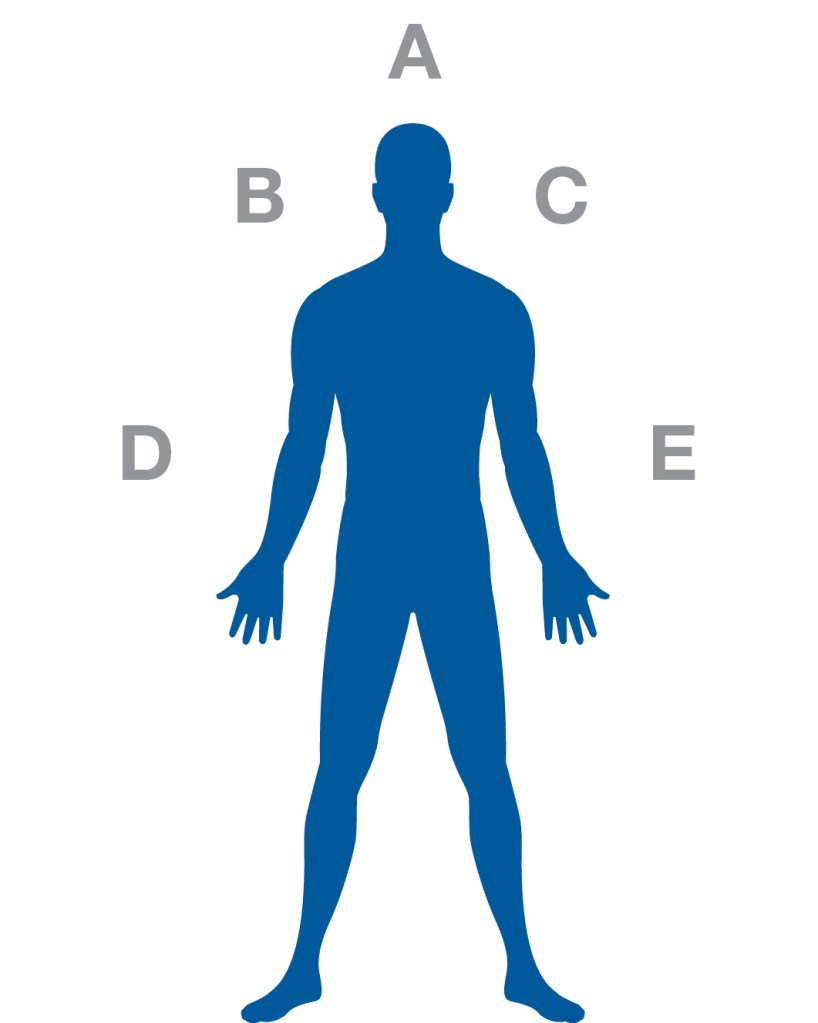Rescuer positioning is an important — and often overlooked — skill.
It’s common during in-service to allow rescuers to place themselves around the victim intuitively or based off past experiences. However, the rescuer’s experience might be limited.
Let’s break down each rescuer position and some their duties.
“A” position is at the top of the head, also called the cephalic position. Opening the airway can be done with either the jaw-thrust maneuver or the jaw-thrust maneuver with head extension. It’s ideal when working with a second or multiple rescuers. Duties include:
• Open and maintain an open airway;
• Open and maintain an airway while delivering breaths from a resuscitation mask;
• Open and maintain an airway while sealing the mask on a BVM;
• Can provide a “Look, Listen, Feel”;
• Can provide a pulse check when spinal precautions are not needed;
• Maintain in-line stabilization on a victim with possible spinal injuries;
• Maintain in-line stabilization while directing the team during backboarding procedures;
• Can leave and activate EMS if needed.
“B” and “C” rescuers go on either side of the victim’s head/shoulder area, also called a lateral position. This also is ideal when working solo. Opening the airway can be done with the head-tilt chin lift. Solo rescuer duties can include:
• Open and maintain an open airway;
• Open and maintain an open airway while delivering breaths from a resuscitation mask;
• Provide “Look, Listen, Feel” with pulse check;
• Roll victim into a supine position if the victim is in a lateral or prone position when spinal precautions are not needed;
• Set-up and use the AED;
• Apply AED pads;
• From “B” position, can easily move to the “D” position to provide chest compressions;
• From “C” position, can easily move to the “E” position to provide chest compressions;
From these positions, multirescuer duties can include:
• Assist with the pulse check while a co-rescuer conducts the “Look, Listen, Feel”;
• Assemble the BVM for use;
• Squeeze BVM bag to provide ventilations;
• Set-up and use the AED;
• Apply the AED pads;
• Leave to activate EMS if needed;
• Set up emergency oxygen delivery system;
• From the “B” position, can easily move to “D” position to provide chest compressions;
• From the “C” position, can easily move to “E” position to provide chest compressions;
If necessary, rescuers at “B” or “C” can assist with chest compressions, ventilations via BVM, and follow commands of the AED while providing care for the victim (two-rescuer team).
“D” and “E” position, on either side of the victim’s chest area, is ideal for providing chest compressions. Additional duties can include:
• Leave to activate EMS if needed;
• Setting up the AED;
• Set up emergency oxygen delivery system;
• Assist “B” and “C” with patient care;
• Taking over for “B” or “C” if necessary;
For two-rescuer teams, AB or AC positioning provides for successful ventilations, chest compressions and AED use. For three-rescuer teams, ABE or ACD positioning provides good space to work and assist each other. In four-rescuer teams, ABCD or ABCE positioning provides redundancy coverage of duties and provides trading out of rescuers if necessary.
MUSICAL POSITIONS DRILL
Five-person teams form a circle, with each member assigned a number between 1 and 5. Music begins to play, and team walks in a circle. Trainer calls out a number and stops the music. The rescuer whose number is called becomes the victim and lies down while the other rescuers take a position.
Objective: Victim and rescuers take appropriate positions. Each rescuer must list at least two duties associated with their position.
Timing Goal: 5 to 10 seconds to position the victim and rescuers, another 10 seconds total to list duties. Once proficient, incorporate these variations quickly and safely:
• Stage a resuscitation mask, BVM without mask, and an AED away from the victim. When the music stops, rescuers must gather the equipment, then move to the victim and take the appropriate position where the equipment is used.
Rescuer without equipment should take either the “D” or “E” position. Add 15 seconds.
• Builds off variation above. Music is not used, but a version of “Duck, Duck, Goose” is utilized, with an additional staging area for the victim. Once the trainer taps the “victim,” the victim rushes to the staging area, while the rescuers rush to gather the equipment then rush to the victim. Total time should be 20 seconds more than the initial total time.
• Variation based off above. Victim is the goose for “Duck, Duck, Goose.” Rescuer sit in a circle of four. Goose victim taps one of the rescuers to become the new victim. Everything else proceeds the same as above.
• There are three victims and nine rescuers. Victims are on the ground in a supine position while rescuers form a circle. Trainer starts the music, and the rescuers walk in a circle. When music stops, rescuers form three groups (two-person team, three-person team, four-person team), rush to the victims and get into the proper position. Add 5 seconds.
Remember: If rescuers better understand the duties for each position, it will reduce confusion and response time to providing the appropriate care, dramatically increase their effectiveness and the quality of care for the victim. Good luck and keep training.
